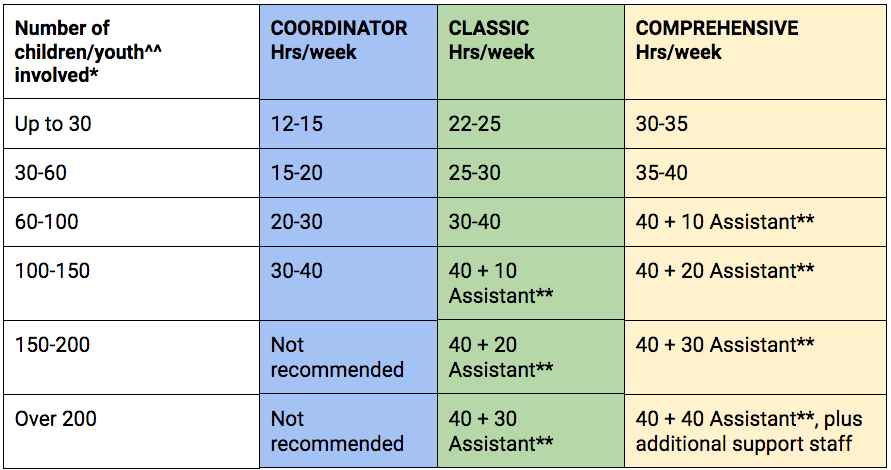On Choosing a Director of Religious Education
Submitted by our Minister, Cathy Harrington
This document was developed by Jan Gartner, UUA Professional Development Associate, with assistance from John Cavallero and Rev. Jude Geiger, in April 2014.
The purpose of this document is to help congregations determine appropriate religious education staffing levels. Given the diverse nature of religious education programming and congregational context, it is unrealistic to provide a precise “formula.” We hope that the information below enables you to have clarifying conversations and to make informed decisions about staffing levels.
This document is the first effort of its kind in a number of years. Feedback welcome. We expect to refine this guidance over time.
Factors to Consider
- Program size (number of people involved)
- Range of ages served (children, children and youth, lifespan)
- Nature of faith formation programming
- Job scope of the religious educator
- Number of worship services or other distinct RE programming times
- Level of volunteer and ministerial support
Every position is unique. There is no way to dictate precise staffing needs based on any individual factor. While we cannot take into account all of the factors above, we attempt to provide some general guidelines.
Relationship Between Program Size and Hours
Some tasks are highly program size-dependent, e.g., volunteer recruitment. Other responsibilities take roughly the same amount of time, whether one is serving 5 children or 500 – for instance, writing a newsletter article or preparing to deliver a time for all ages (each of which takes in the range of 1.5 to 3 hours to do well).
Job Scope
Take a moment to consider where your position falls on the continuum below, relative to the three job scope levels outlined: Coordinator, Classic, and Comprehensive. (Nearly all positions are “hybrids.” The descriptions below are not intended to represent exact job descriptions.)
| COORDINATOR: Administrative and Volunteer Support
A primarily administrative role supporting a religious education program for children and/or youth. Not a director-level position. Typically works independently on well-defined tasks and cooperatively with ministerial and lay leadership. Responsibilities focused on:
Coordinator positions might be most appropriate for:
|
| CLASSIC: Director of Religious Education
This is intended to represent a typical scope of work for a religious educator. Works autonomously with a moderate level of authority and expectations of collaboration with minister and other staff. Overall accountability (which may involve delegation) for coordinator responsibilities listed above, plus attending to many or most of the following:
A Classic Director of Religious Education position might be most appropriate for:
|
| COMPREHENSIVE: Lifespan Faith Formation Ministry
A well-developed lifespan position that goes well beyond children’s programming to provide overall leadership for all ages in the area of faith formation, including integration with multiple areas of church life. In collaborative relationship with staff team and operates with a high level of authority within the program area. Attends to most of the above (Coordinator and Classic, delegating as appropriate), as well as many of the following:
A Comprehensive Lifespan Faith Formation Ministry position might be most appropriate for:
|
Once you have determined where your religious educator position falls on the above continuum, look at the chart below for guidance on appropriate hours relative to program size.
Staffing for Success
Consider the chart below a starting point, keeping in mind all of the factors listed at the top of this document.
^^ The number of adults served is not explicitly taken into account in this chart. If the position is lifespan, be sure to consider the needs and expectations of adult programming responsibilities.
* “Involved” means overall participation over time. We recognize that formal enrollment practices and attendance patterns vary, and that some faith development initiatives fall outside of Sunday mornings. How many children/youth is the religious educator keeping track of and serving in some fashion? (Consider that inconsistent attendance and families absent for a period of time require extra planning and follow-ups.)
** Assistant – RE Assistant or strategic staffing, e.g., youth coordinator, clerical assistant.

